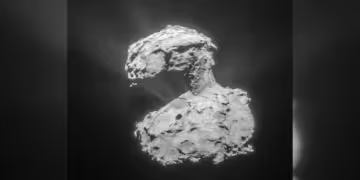The origins of Earth’s water have long puzzled scientists, sparking debates and inspiring research into the mysteries of our planet’s hydrosphere. Recently, a groundbreaking study has reignited the discussion, suggesting that comets, especially those from the Jupiter family, may have played a pivotal role in delivering water to Earth billions of years ago.
The Unique Signature of Earth’s Water
Earth’s water has a unique molecular fingerprint, and comets might hold the key to its origins. Scientists have discovered that water on Earth has a specific ratio of deuterium—a heavier isotope of hydrogen—to hydrogen. This ratio acts as a molecular signature, helping researchers trace the origins of water across celestial bodies. Data from Rosetta’s analysis of Comet 67P/Churyumov-Gerasimenko revealed a striking similarity between the D/H ratio in the comet’s water and Earth’s oceans.
This finding challenges earlier assumptions that comets contributed little to Earth’s water, primarily because many comets had D/H ratios inconsistent with Earth’s. The revelation that water from Comet 67P aligns with Earth’s signature suggests that Jupiter-family comets could have been significant contributors to our planet’s water supply.
How Comets Deliver Water to Planets
The journey of water from comets to planets is a tale of cosmic interaction and transformation. When comets approach the Sun, their icy surfaces warm, releasing gas and dust. This process creates a coma—a glowing envelope of gas and particles surrounding the comet’s nucleus. Researchers found that water containing deuterium tends to stick more readily to dust grains than regular water.
As the ice on these grains sublimates, it releases water vapor into the coma, altering the observed D/H ratio.
Why This Matters: Earth’s Water Origins
Understanding the origins of Earth’s water is crucial for unraveling the mysteries of our planet’s habitability. Water is essential for life, and knowing where it came from helps scientists piece together the story of how Earth became a life-sustaining world. The latest findings suggest that comets, alongside asteroids, delivered a substantial portion of Earth’s water during the heavy bombardment phase of the early solar system, around 4 billion years ago.
The Rosetta Mission: Unlocking Cosmic Secrets
The Rosetta mission has been instrumental in advancing our knowledge of comets and their role in the solar system. Launched by the European Space Agency in 2004, Rosetta became the first spacecraft to orbit a comet and deploy a lander, Philae, onto its surface. Its observations of Comet 67P provided unprecedented insights into the composition of cometary material, including water, organic compounds, and minerals.
By analyzing the data collected by Rosetta, researchers could investigate the isotopic makeup of water on Comet 67P, leading to the groundbreaking discovery of its similarity to Earth’s water.
Implications for the Early Solar System
The findings have profound implications for our understanding of the early solar system and the processes that shaped it. Comets are remnants of the solar system’s formation, preserving material from its earliest days. By studying their composition, scientists can glean insights into the conditions that existed billions of years ago.
The discovery that Jupiter-family comets contain water with Earth-like D/H ratios suggests that the early solar system was more dynamic and interconnected than previously thought.
What Makes Comet 67P Special?
Comet 67P stands out as a cosmic laboratory, offering unique insights into water delivery mechanisms. Its orbit, composition, and behavior make it an ideal candidate for studying the connections between comets and planetary water reservoirs. Unlike some other comets, 67P’s water vapor closely matches Earth’s molecular signature, providing a rare opportunity to test hypotheses about water’s cosmic origins.
Moreover, 67P belongs to the Jupiter family of comets, which are thought to have formed in the outer solar system before migrating inward.
The Role of Advanced Technology in Space Exploration
Breakthroughs like these highlight the importance of advanced instruments in unraveling cosmic mysteries. The ability to measure isotopic ratios with precision is a testament to the technological advancements of missions like Rosetta. These tools allow scientists to probe deeper into the molecular makeup of celestial bodies, uncovering details that were previously inaccessible.
As space agencies develop next-generation missions, such as NASA’s upcoming comet sample-return projects, the potential for even more groundbreaking discoveries grows. Each mission builds on the last, creating a cascade of knowledge that brings us closer to understanding our place in the cosmos.
Conclusion: A Cosmic Mystery Partly Solved
The discovery that comets may have brought water to Earth billions of years ago is a monumental step in understanding our planet’s history and its place in the universe. Thanks to missions like Rosetta, scientists are unraveling the intricate connections between celestial bodies, shedding light on the origins of life’s most essential ingredient. This research reminds us of the profound interconnectedness of the cosmos.
Reference:
A nearly terrestrial D/H for comet 67P/Churyumov-Gerasimenko



















